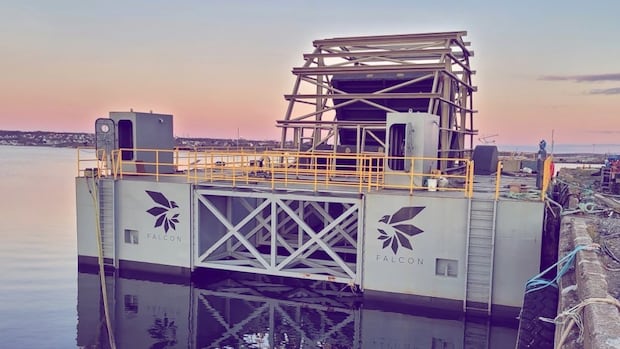Meet the Nova Scotians on the frontiers of farming kelp
In a darkened garage down a long driveway in the community of Lower West Pubnico, N.S., spools of twine sit in a fishing tank.
This is aquaculture site 1456, which owner Charlene LeBlanc calls “probably the smallest aquaculture site in the province,” — an ad-hoc hatchery that started in a cooler, and can now produce thousands of feet of seeded line for would-be kelp farmers.
In this tank, Leblanc is coaxing microscopic kelp spores, taken from the reproductive tissue of wild algae, to attach to the spools of twine.
“It’s a lot like Christmas — I can’t wait to check,” she says. “I still have to tell myself, ‘OK, it’s only been a day. Let’s give it another day to see if it’s changed.'”
After approximately two months, these lines should be brown and fuzzy with baby kelp, and ready to be wound around fishing lines and strung between buoys in the ocean, so that the kelp grows vertically in the water column.
‘Perfectly suited’ for kelp
This kelp hatchery, LeBlanc Seeded Lines, is part of a grassroots effort to create an industry that some are hoping will support sustainable coastal livelihoods.
Seaweed aquaculture is a rapidly growing industry across eastern North America, and in Nova Scotia, proponents of kelp farming say the province is the perfect position to participate.
If the ocean was a forest, kelp would be the trees; it’s the largest marine algae in the intertidal and subtidal zone, providing habitat for a range of other species. Kelp also pulls excess nutrients like nitrogen and phosphorus out of the water, supporting healthy ecosystems.
Atlantic Voice26:10Farming the Underwater Forest
Featured VideoFrom nurturing baby seaweed in a garage, to serving up it for supper: there’s a world of possibilities growing around kelp in Nova Scotia. Freelance producer Moira Donovan dives into the fledgling industry that could support a new wave of people making a living from the sea, even as the climate changes.
But the kinds of kelp that grow in the waters around Nova Scotia — including sugar kelp, whose frilly blades can reach as long as five metres — also have other uses. Kelp grown commercially is increasingly used as a nutrient additive and fertilizer, and in bioplastics and beauty products.
“We are perfectly suited for growing kelp,” said Shannon Arnold, the associate director of marine programs with the Ecology Action Centre.
“We have the right type of ecosystem, we have availability for small farms, it clearly grows quite well.”
Showing that off is part of the mission of Kelp Kurious, a demonstration project run by Arnold and the Ecology Action Centre. With kelp growing on a shellfish lease outside Mahone Bay, it’s meant to be a trial run for the industry in Nova Scotia.
“We’re trying to take away some of that risk … there’s all these little tests that we’re doing, that hopefully when small farmers get their licences and get going, they’ll be ready to take over those markets,” said Arnold.
Kelp Kurious has partnered with Peter Darnell, the owner of Indian Point Marine Farms and a scallop farmer, on the project. “I’m happy to see the place utilized,” he said.
For shellfish farmers, the real advantage of kelp is that it utilizes the productivity of the ocean.
Kelp grows throughout the winter, when the water is highest in nutrients, and is harvested in the spring. In doing so, it avoids some of the issues that plague shellfish farmers — like invasive species — and offers a viable second business at a time when farmers and many fishers aren’t busy.
“Seaweed farming looks like a niche that should be filled,” said Darnell. “It’s there at the right time and avoids a lot of the issues that are there for shellfish, so why not?”
Aside from shellfish farmers, Arnold said the people who’ve participated in Kelp Kurious workshops for potential growers come from different backgrounds in coastal communities.
“Our predominant interest has been from folks who are not coming directly from fishing, which is interesting, and just have other interests in getting some sort of skill on the water or who want to be growing their own food.”
The low capital costs associated with kelp farming also mean the industry is attracting interest from groups that are not always represented in the conventional fishing industry, said Arnold, including women and Mi’kmaw communities.
But as it stands, farmers currently face a high regulatory burden. Arnold said policy barriers currently make it difficult for even small, low-risk kelp farms to get up and running. She said that could cause Nova Scotia to be outpaced by other kelp-producing jurisdictions, such as Maine.
“If we continue to have really onerous regulations that stop small businesses then unfortunately, we think we would get left behind by others who will develop it more quickly.”
In an email, Nova Scotia’s Department of Aquaculture and Fisheries said it recognizes “the benefit of marine plant aquaculture and we’re working to encourage growth in that sector,” which includes reducing the regulatory burden for marine plant farmers.
Seaweed for supper
Either way, the kelp industry needs more than supply; a core question remains how the kelp produced on farms would be used. In southern Nova Scotia, one chef is trying to build up local demand by making kelp taste as delicious as possible.
On Yarmouth’s main street, Pamela Leonforde is transforming a longstanding candy store long known as Toots into a bright vegan café, where she hopes kelp will be on the menu.
Leonforde, who is from Saint Lucia, grew up watching the adults around her sipping a drink made from sea moss, another kind of seaweed. But it wasn’t until coming to Nova Scotia that she saw kelp used as a raw ingredient.
After experimenting with recipes— including kelp crackers, vegan fish sauce with sugar kelp, and cheesecake with sugar kelp — Leonforde saw the potential for kelp as an ingredient, and plans to offer kelp as a consistent part of her menu come summertime.
“I am hoping that by my impact on a community scale people will begin to see how much I appreciate being in a fishing community, and how many resources there are other than fish,” she said.
“There are so many raw natural resources available to us, particularly the marine resources, that we are not tapping into.”
Climate change and kelp
But even as people start looking to kelp as an untapped resource, climate change is reshaping kelp’s future.
In a lab just outside Halifax, blades of sugar kelp tumble gently in a thousand-litre tank. Scientists collected these blades in Pubnico and St Marys Bay in October — a time when kelp, which becomes reproductive in response to decreased daylight and water temperatures, should have already been ready to produce spores.
But in 2022 and 2023, sea surface temperatures in the North Atlantic were the warmest ever recorded.
“What’s been happening more and more recently is the water temperature is not dropping as drastically in September and October as we would have expected 10 years ago,” said Stephen O’Leary, research team lead with the National Research Council.
Instead, these blades have had to be kept until they started producing spores — part of a research project that supports kelp’s viability in a changing climate, and the burgeoning kelp industry, simultaneously.
The project is also collecting reproductive material from wild kelp to build a seed bank of genetic material, which could be used to restore native or endemic kelp from areas where it’s lost due to pollution or climate impacts.
“In those cases we’d be looking at if we can identify individuals from a kelp population, for example, that will be resistant to the new normal to the elevated winter and late fall water temperatures,” said O’Leary. Those naturally resistant individuals could then be used to repopulate an area.
While the seed bank is also of direct interest to farmers — as it could be used to identify and propagate individual kelp that have useful commercial traits — it also points to the need for the kelp industry to consider the increasing unpredictability that climate change will bring.
“It is an interesting time to be developing that industry, because it’s a time where we’re dealing with a lot of moving parts,” said O’Leary. “If the industry is going to thrive and remain sustainable, it’s going to have to adapt to the changes that we’re seeing in the climate now.”
Along Nova Scotia’s coastline, the difficulties associated with those changes are significant — in some places, wild kelp beds have almost completely disappeared due to warming water. But kelp proponents say cultivating kelp still offers hope for a more sustainable future, despite the challenges.
“We’re showcasing right now what we think could be the future of green economic opportunities and what we could be doing differently,” said Arnold.
“It’s really hard to imagine a different future if you can’t see a part of it happening.”
MORE TOP STORIES




